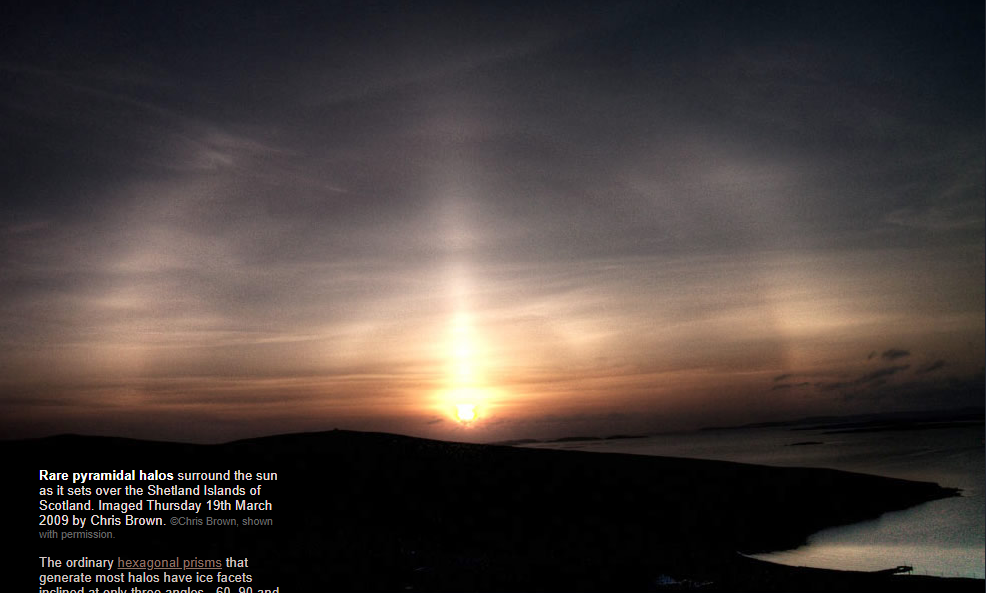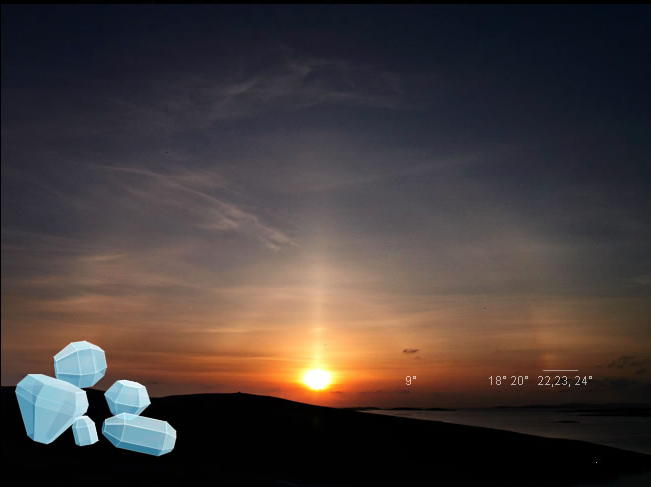Shetland Pyramids
Exploring the Enigmatic Shetland Pyramids
The enchanting phenomenon of pyramidal halos has captured the attention of skygazers and atmospheric optics enthusiasts alike. While most halos are created by ordinary hexagonal ice prisms, the Shetland Islands of Scotland have revealed a rare spectacle - pyramidal ice crystals with up to 20 sides. These unique ice crystals possess facets inclined at numerous angles, ranging from 28 to 90 degrees. As these crystals tumble through the atmosphere, they generate a captivating display of circular halos, commonly referred to as 'odd radius halos'.
The Shetland pyramids offer a visual feast for those fortunate enough to witness their elusive presence. Among the array of halos that embellish the sky during this enchanting phenomenon, several stand out:
-
9° Halo: Extending outward from the setting sun, a distinct 9° halo commands attention, encircling the solar disk with its ethereal glow.
-
18 and Possibly 20 Degree Halos: Fragments of 18 and potentially 20 degree halos add to the mesmerizing tapestry of atmospheric optics, captivating observers with their subtle yet captivating presence.
-
22, 23, and 24° Circles: Further along the celestial expanse lies a broad band in the position of the 22, 23, and 24° circles. These three halos, although notoriously challenging to discern individually, contribute to the overall celestial spectacle.
Pyramidal halos are an intriguing departure from their more common hexagonal counterparts. Their unique structure and multitude of inclined facets give rise to an intricate interplay of light and ice, resulting in a mesmerizing display that captivates onlookers.
The origin of these pyramidal ice crystals lies within the complex dynamics of atmospheric conditions. As temperatures plummet and moisture freezes, ice crystals form and take on various shapes. The Shetland pyramids, with their remarkable 20-sided structures, are a testament to the complexity of atmospheric ice formation.
As light traverses the myriad of inclined faces within these pyramidal crystals, it undergoes multiple refractions and reflections. This intricate dance between light and ice results in the formation of circular halos, each with its distinct radius and intensity. The pyramidal crystals' ability to refract light at odd angles gives rise to the aptly named 'odd radius halos,' adding an air of mystery and wonder to the atmospheric spectacle.
To fully appreciate the beauty of the Shetland pyramids, it is essential to understand the role of meteorological conditions in their creation. A combination of low temperatures, high humidity, and just the right amount of ice crystal diversity is required for these pyramidal halos to grace the sky. This delicate balance of atmospheric factors contributes to the rarity and elusive nature of this awe-inspiring phenomenon.
Capturing the magic of the Shetland pyramids through photography is a pursuit that requires both skill and patience. The intricate details of these halos can be challenging to capture accurately, often necessitating specialized equipment and techniques. However, those fortunate enough to witness this celestial spectacle firsthand are rewarded with a visual feast that transcends words.
In conclusion, the enigmatic Shetland pyramids offer a captivating glimpse into the fascinating world of atmospheric optics. Their rare presence and intricate structure add an ethereal touch to the sky above the Scottish islands. As we marvel at these pyramidal halos and their odd radius counterparts, we are reminded of the profound beauty and complexity that lies within our natural world.

Rare pyramidal halos surround the sun as it sets over the Shetland Islands of Scotland. Imaged Thursday 19th March 2009 by Chris Brown. ©Chris Brown, shown with permission.
The ordinary hexagonal prisms that generate most halos have ice facets inclined at only three angles - 60, 90 and 120° - to one another.
In contrast, pyramidal ice crystals with up to 20 sides have their facets inclined at many more angles - 28,52,56,60,62,64,80 and 90 degrees.
As they tumble, light passing between these variously inclined faces produces a series of circular halos often called 'odd radius halos'.
The Shetland display had most of them.
Outwards from the setting sun is a distinct 9° halo. There are fragments of 18 and possibly 20 degree halos. Beyond that is a broad band in the position of the 22,23 and 24° circles. These last three are characteristically difficult to see as separate halos.

Note: this article has been automatically converted from the old site and may not appear as intended. You can find the original article here.
Reference Atmospheric Optics
If you use any of the definitions, information, or data presented on Atmospheric Optics, please copy the link or reference below to properly credit us as the reference source. Thank you!
-
<a href="https://atoptics.co.uk/blog/shetland-pyramids/">Shetland Pyramids</a>
-
"Shetland Pyramids". Atmospheric Optics. Accessed on April 20, 2024. https://atoptics.co.uk/blog/shetland-pyramids/.
-
"Shetland Pyramids". Atmospheric Optics, https://atoptics.co.uk/blog/shetland-pyramids/. Accessed 20 April, 2024
-
Shetland Pyramids. Atmospheric Optics. Retrieved from https://atoptics.co.uk/blog/shetland-pyramids/.